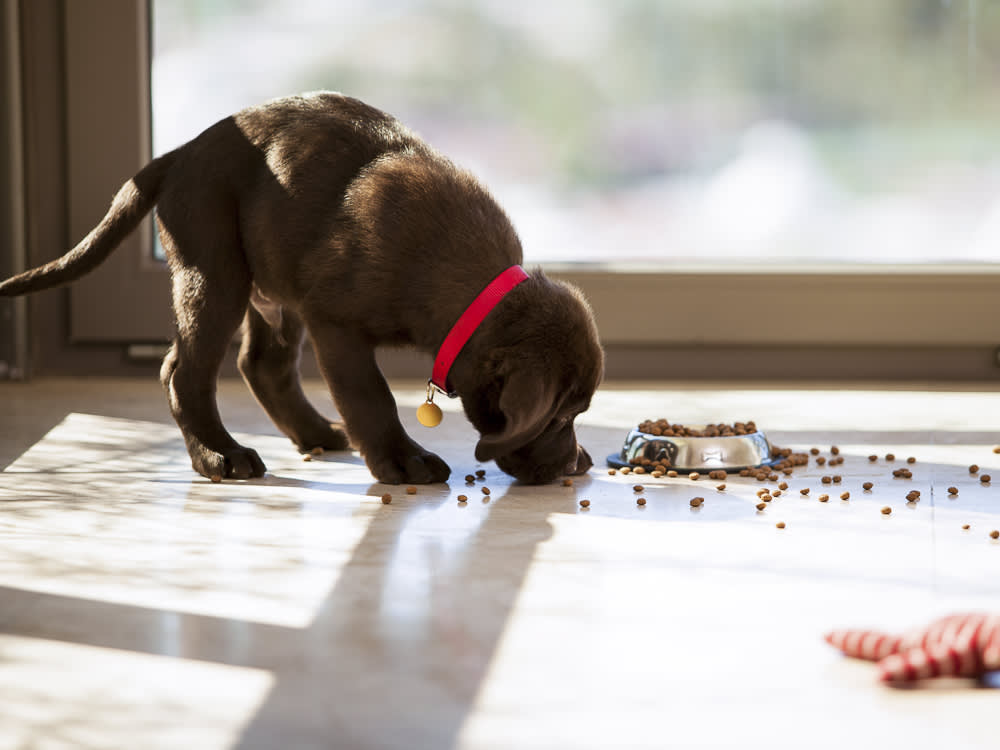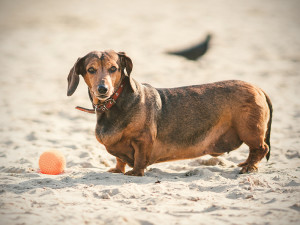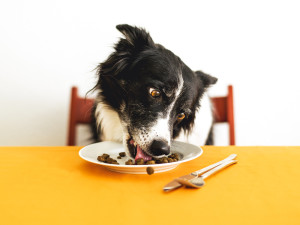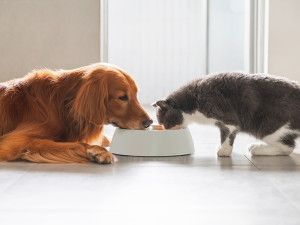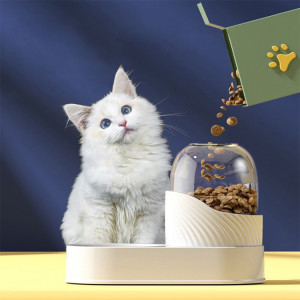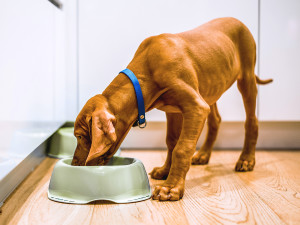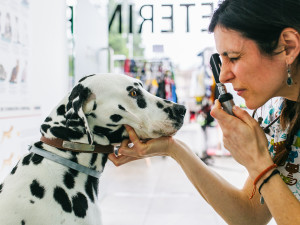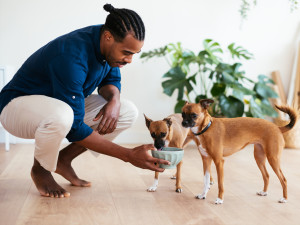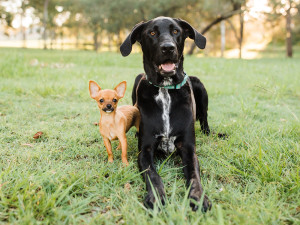What’s in a Cup?
A dog food measurement by any other name would be confusing.
Your dog is motivated by simple things: Belly rubs. A game of catch in the yard. Food. Oh, the food. Treats, dinner, breakfast, peanut butter in a Kong ball. Food is life, which means your dog probably doesn’t let you miss a feeding period. No matter who has the food scoop at mealtime, your dog will be by their side — ready and waiting.
Whatever your regimen, you may think how much to feed your dog is a no-brainer. But according to a studyopens in new tab, many dog owners do not measure food accurately, putting their dogs at risk of under-nourishment or (in most cases) weight gain, which leads to obesity. This may be, in part, because of vague dog food labels and confusion around how much “a cup” of dog food really is.
Many vets believe that understanding how much to feed your dog is one of the biggest factors in the worldwide epidemic of pet obesity. It really matters to your dog’s overall health to get feeding right. So, knowing not only the correct amount of food to give to your dog, but how to actually measure it out, is important. Keep reading to learn everything you need to know.
Understanding Dog Food Labels
AAFCOopens in new tab (Association of American Feed Control Officials) labeling instructions don’t make it easy for consumers. On pet food packaging you will see vague feeding guidelines such as: “For a dog 40 to 60 pounds, feed 1 to 2 cups daily.” These instructions are imprecise not only because of the wide weight range, but also because of the use of the generalized word “cup.” If you use one of the standard measuring cups found in your kitchen — like a popular Pyrex one — and fill it with dog food, you might wind up under (or more likely over) feeding your dog. It’s a really essential point because that kind of measuring cup is intended to measure fluids, not dry goods.
As any baker knows, the measuring standard “one cup equals eight ounces” doesn’t translate the same to dry matter (like kibble or flour) as it does to liquids. A more accurate way to express feeding recommendations would be to provide the instructions in actual ounces or grams, such as: “Feed a 20 lb. dog 6 oz. of food daily,” and ditch the word “cup” altogether.
What you also need to know is how many calories there are in the food you feed your dog. According to AAFCO, the calorie density must appear on pet food packaging in the metric form kcal/kg (aka, kilocalories per kilogram). Using metrics like that further complicates things when the feeding amounts themselves are given in cups. Plus, for those of us who do not use metric measurements, we need to convert the kcal/kg to kcal/oz and feed accordingly. Head to the end of the article for the formula.
Consider this possible scenario: The Daily Energy Requirement opens in new tab(DER) for a 20-pound, neutered, adult dog is 586 kcal, and perhaps you calculated that the food you’re giving them has 97.9 kcals per ounce. This means your dog should be fed 5.9 ounces of that food, not 8 ounces, as could be the case if you’re using a standard measuring cup and filling it to the top. Even slight variations in how many calories a dog consumes daily can have a large effect over time.
As pet food consumer advocate Susan Thixton notes on truthaboutpetfood.comopens in new tab, AAFCO is pondering the inclusion of an explanation of calorie amounts per cup. Personally, I don’t think that will solve the problem, because we would still be stuck with the “When is a cup not a cup?” riddle.
What is “a Cup” of Dog Food, Exactly?
A few of the brands I checked with, including The Honest Kitchen and Orijen (made by Champion Petfoods), actually define their cup as being around 4.0 oz. for the former and 4.2 oz. for the latter, which allows you to determine how many calories you’re actually feeding your dog.
I was told by a representative from The Honest Kitchen that this was a “standard” dry measuring cup, although they do not provide that definition on their site or packaging and, besides that, there really isn’t anything like a standard “cup” when it comes to dog food. And to complicate matters even further, small print in the textbook, Small Animal Clinical Nutrition (4th Edition), notes that “an 8-oz. measuring cup can hold 3 to 3.5 oz. by weight of most dry pet foods or 3.5 to 5 oz. of most semi-moist pet food.” In other words, there is little consistency in the pet food industry, which creates a lot of confusion for pet parents.
ZiwiPeak is among the few companies to provide a handy scoop tailored to their food, which is very helpful as long as you remember to only use that scoop. Their air-dried food is a very dense 5,600 kcal/kg, or a whopping 158 kcal/oz. Their scoop measures two ounces (or 316 kcals), which they note on the scoop itself and on the bag. But, like many pet-food bags, the calorie content statement appears beneath the nutritional Guaranteed Analysis panel on one side of the package and the feeding guidelines are listed on the other side. You may have to search to find this valuable information.
Oddly, you can’t count on finding it on every manufacturer’s website, which makes it doubly worthwhile to consult the packaging and call the company to verify.
Are Scoops a Good Option For Measuring Dog Food?
To figure this out, I set up an experiment with a variety of common kitchen ingredients and an array of kitchen measuring cups, plus two scoops specifically made for pet food. The cups included three popular slant-sided glass Pyrex cups of various sizes and a variety of straight-sided cups (supposedly meant for dry ingredient measuring). I portioned out sugar, flour, and several types of grain and weighed them on a digital scale.
To my surprise, every one of the measuring devices provided different weights for each ingredient. Even though the scoop-type cups are meant to measure dry weight, it is difficult to get it exact because ingredients need to be leveled off with a flat edge or packed down/added to, which can be complicated when you’re working with dense or large grain-sized foods. Many websites devoted to baking (where precision matters) often note that weights can even vary according to how you actually scoop out an ingredient, such as flour, from a storage container; therefore, they always recommend the use of a digital scale over standard measuring utensils.
Next, I used a couple of scoop sets by Petfactors and Rypet designed specifically to measure pet food. They did a much better job than a kitchen measuring cup, but because of the vast range of kibble dimensions and sizes, they too can miss the mark. Remember: When using this type of scoop, it’s important to not go over or under the measurement-indicator line (it’s there for a reason!).
The Best Way to Measure Dog Food Is On A Digital Scale
At the end of the day, the most precise way to measure your dog’s food is to weigh it with a food scale. Scales are inexpensive and very handy to have in a kitchen. If in doubt about how much to feed your dog, check with your vet to confirm your dog’s weight, body condition scoring, and target calorie needs, which will determine the amount of food they need (in ounces or grams). Remember: Feeding your dog the correct amount of food is the best way to keep them trim, fit, and healthy!
Important Weight Conversions: To convert kcals/kg into kcals/oz., divide the number of kcals by 35.27 (the number of ounces in a kilogram). For example, if the label indicates that a food has 3,456 kcals/kg, divide that by 35.27, and get 97.9 kcal/oz. And to convert grams to ounces, divide the grams by 28.35. Or even easier, use Google to do the conversion!
